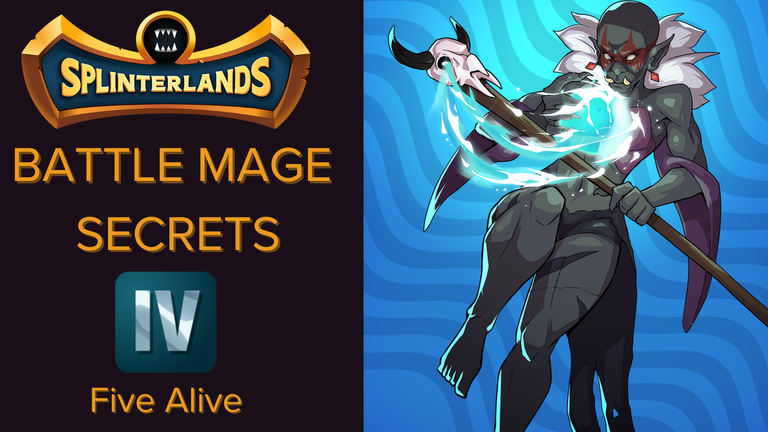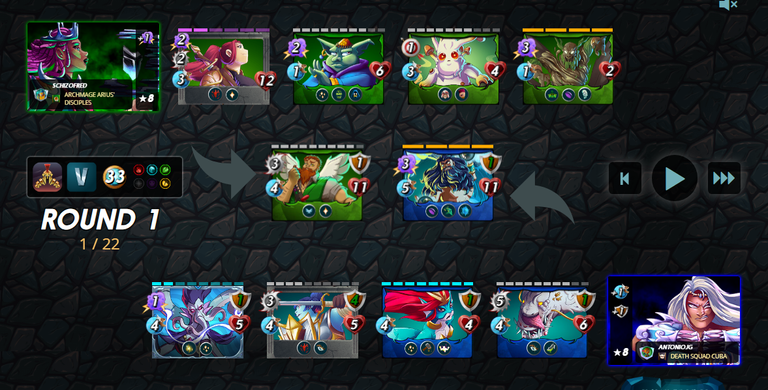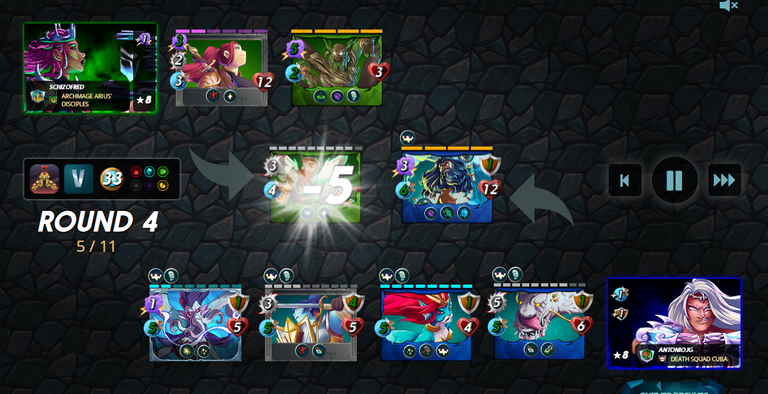Five Alive Ruleset - Una estrategia interesante usando doble “Opportunity” con el Splinter de Agua [Es/En]

Español
¡Saludos comunidad! El reto de esta semana es sobre una regla de batalla que sólo permite utilizar hasta 5 unidades en la batalla. En la siguiente sección se explicará más a detalle, por lo que tener en cuenta este aspecto en el análisis para formar nuestras estrategias, es un factor clave con un impacto considerable en el desempeño de las mismas. Es importante recordar que el tipo de ofensiva a utilizar en nuestras estrategias también dependerá del resto de reglas presentes en la batalla.
En esta oportunidad, les explicaré cómo afronté una batalla de Ranked de la liga de Plata en el formato Moderno, enfocando mi análisis en explicar cómo utilicé al Splinter de Agua, el invocador Kelya Frendul y las unidades Djinn Oshannus, Deeplurker, Merdaali Guardian, Isgald Vorst y Anasth Soothsayer para ser coherente con las reglas de batalla presentes y las habilidades que quería combinar con la finalidad de tomar ventaja en la partida con la estrategia planteada.
Ya que estos aspectos son un factor clave con un impacto considerable en el desempeño de nuestras estrategias.

Five Alive Ruleset

Five Alive es una regla que sólo permite utilizar hasta 5 unidades en la batalla.
Entonces, conociendo estos detalles, es importante estár familiarizado con las unidades que podríamos llegar a combinar bajo estas circunstancias para decidir con más facilidad y tomar ventaja en la batalla.

Conjunto de reglas y elección

Hablemos sobre el conjunto de reglas presentes en la batalla, este es el punto de partida para iniciar el análisis que nos llevará a la elección más adecuada para afrontar la batalla.
Límite de maná igual a 33 puntos, esta cantidad nos permite elegir invocadores con un costo de maná entre 4 y 7 puntos. Es importante tener una estrategia definida para aprovechar adecuadamente el maná restante para la elección de las unidades.
La regla “Five Alive” ya la expliqué a detalle en la sección anterior. Por otra parte, Are You Not Entertained?, es una regla que permite utilizar una unidad Gladius en la batalla.
Entonces, tomando en cuenta todos estos aspectos, decidí utilizar al Splinter de Agua, ya que cuenta con unidades que poseen buenas estadísticas, entre ellas, un buen daño melee y mágico. También cuenta con habilidades como: “Void”, “Phase”, “Forcefield”, “Opportunity”, “Poison”, “Tank Heal”, “Repair”, “Strengthen”, “Bloodlust”, “Cleanse”, entre otras y con un invocador que incrementa en 1 punto la armadura y velocidad del equipo.

Equipo y estrategia

Hablemos sobre el equipo y la estrategia que conforma. Dadas las circunstancias, era evidente el uso de cualquier tipo de daño. Es por ello que decidí elegir al invocador Kelya Frendul, ya que incrementa en 1 punto la armadura y velocidad del equipo.
Djinn Oshannus fue el tanque en esta oportunidad, ya que cuenta con buenas características, entre ellas, un elevado daño mágico, velocidad y vida. También posee la habilidades “Void”, “Phase” y “Forcefield”, las cuales le permiten resistir un poco más los ataques enemigos.
Deeplurker tiene una participación clave en la estrategia, ya que además de atacar directamente a las unidades más débiles del equipo enemigo, proporciona cierta ventaja una vez aplique la habilidad “Poison”.
Merdaali Guardian tiene el objetivo de dar soporte al tanque mediante la habilidad “Tank Heal” y al equipo en general mediante las habilidades “Repair” & “Strengthen”.
Isgald Vorst también tiene un rol clave en la estrategia, ya que además de atacar directamente a las unidades más débiles del equipo enemigo, se hace mucho más fuerte mediante la habilidad “Bloodlust”, cada vez que mata a una unidad.
Anasth Soothsayer colabora con Merdaali Guardian para dar soporte al tanque mediante las habilidades “Tank Heal” & “Cleanse”. Con la diferencia que también construye con su daño mágico.

Five Alive Ruleset en acción

Como les mencioné anteriormente, elegir al invocador Kelya Frendul y las unidades Djinn Oshannus, Deeplurker, Merdaali Guardian, Isgald Vorst y Anasth Soothsayer, fue una buena opción. Sin embargo, también es importante incluir habilidades de soporte que le permitan a nuestro tanque y al resto del equipo, resistir lo suficiente.
Observen como para el turno 5 de la ronda 4, el equipo enemigo estaba casi abatido. Djinn Oshannus defendió la primera posición sin problemas, esto fue gracias al soporte brindado por Merdaali Guardian y Anasth Soothsayer. Por otra parte, la contribución de Deeplurker y Isgald Vorst fue clave para debilitar al enemigo.
Si quieres ver la batalla completa, acá te dejo el enlace: CLIC PARA VER LA BATALLA

Conclusión
La estrategia planteada hizo un uso eficiente de la cantidad de maná disponible, cubriendo aspectos tales como: resistencia contra el daño enemigo, soporte del equipo, una buena ofensiva, y coherencia con el conjunto de reglas presente.
Una debilidad de esta estrategia es un equipo enemigo que cuente con una ofensiva que tenga un elevado daño melee e incluya en su estrategia habilidades como: “Sneak”, “Opportunity”, “Thorns”, “Retaliate”, “Protect”, “Repair”, entre otras.
La diferencia entre las estrategias fue que las unidades en la segunda línea enemiga no contaban con las habilidades de soporte suficientes para resistir el daño de mi ofensiva, por lo que fueron abatidas rápidamente.
Para el funcionamiento adecuado de nuestras estrategias, es importante considerar todos los aspectos involucrados, por lo que no sólo debemos enfocarnos en las estadísticas y habilidades a combinar. También debemos tener en cuenta la influencia de los conjuntos de reglas sobre la estrategia.
Este ha sido mi aporte al desafío semanal, ¡Espero haya sido de su agrado! ¡Saludos y hasta la próxima semana!

English
Greetings community! This week's challenge is about a battle rule that only allows using up to 5 units in battle. In the next section it will be explained in more detail, so taking into account this aspect in the analysis to form our strategies, is a key factor with a considerable impact on the performance of the same. It is important to remember that the type of offensive to use in our strategies will also depend on the rest of the rules present in the battle.
In this opportunity, I will explain how I faced a Silver League Ranked battle in the Modern format, focusing my analysis on explaining how I used the Water Splinter, the summoner Kelya Frendul and the units Djinn Oshannus, Deeplurker, Merdaali Guardian, Isgald Vorst and Anasth Soothsayer to be consistent with the battle rules present and the skills I wanted to combine in order to take advantage in the game with the strategy proposed.
Since these aspects are a key factor with a considerable impact on the performance of our strategies.

Five Alive Ruleset

Five Alive is a rule that only allows up to 5 units to be used in battle.
So, knowing these details, it is important to be familiar with the units that we could combine under these circumstances to decide more easily and take advantage in battle.

Rulesets and choise

Let's talk about the set of rules present in the battle, this is the starting point to begin the analysis that will lead us to the most appropriate choice to face the battle.
Mana limit equal to 33 points, this amount allows us to choose summoners with a mana cost between 4 and 7 points. It is important to have a defined strategy to properly use the remaining mana for the choice of units.
The "Five Alive" rule was explained in detail in the previous section. On the other hand, Are You Not Entertained, is a rule that allows you to use a Gladius unit in battle.
So, taking all these aspects into account, I decided to use the Water Splinter, since it has units with good stats, including good melee and magic damage. It also has abilities such as: "Void", "Phase", "Forcefield", "Opportunity", "Poison", "Tank Heal", "Repair", "Strengthen", "Bloodlust", "Cleanse", among others, and a summoner that increases the team's armor and speed by 1 point.

Team and strategy

Let's talk about the team and its strategy. Given the circumstances, it was obvious to use any kind of damage. That's why I decided to choose the summoner Kelya Frendul, since it increases the armor and speed of the team by 1 point.
Djinn Oshannus was the tank this time, since he has good characteristics, among them, high magic damage, speed and life. He also has the "Void", "Phase" and "Forcefield" abilities, which allow him to resist enemy attacks a little more.
Deeplurker has a key role in the strategy, since in addition to directly attacking the weakest units of the enemy team, it provides a certain advantage once the "Poison" skill is applied.
Merdaali Guardian has the objective of supporting the tank through the "Tank Heal" skill and the team in general through the "Repair" & "Strengthen" skills.
Isgald Vorst also has a key role in the strategy, since in addition to directly attacking the weakest units of the enemy team, he becomes much stronger through the "Bloodlust" skill, every time he kills a unit.
Anasth Soothsayer collaborates with Merdaali Guardian to support the tank through the "Tank Heal" & "Cleanse" abilities. With the difference that it also builds with its magic damage.

Five Alive Ruleset in action

As I mentioned before, choosing the summoner Kelya Frendul and the units Djinn Oshannus, Deeplurker, Merdaali Guardian, Isgald Vorst and Anasth Soothsayer was a good choice. However, it is also important to include support abilities that allow our tank and the rest of the team to resist enough.
Notice how by turn 5 of round 4, the enemy team was almost down. Djinn Oshannus defended the first position without problems, this was thanks to the support provided by Merdaali Guardian and Anasth Soothsayer. On the other hand, the contribution of Deeplurker and Isgald Vorst was key to weaken the enemy.
If you want to see the complete battle, here you have the link: CLICK TO WATCH THE BATTLE

Conclusion
The strategy proposed made an efficient use of the amount of mana available, covering aspects such as: resistance against enemy damage, team support, a good offensive, and coherence with the present set of rules.
A weakness of this strategy is an enemy team with an offensive that has high melee damage and includes in its strategy abilities such as: "Sneak", "Opportunity", "Thorns", "Retaliate", "Protect", "Repair", among others.
The difference between the strategies was that the units in the enemy's second line did not have enough support skills to resist the damage of my offensive, so they were quickly killed.
For the proper functioning of our strategies, it is important to consider all the aspects involved, so we must not only focus on the statistics and skills to combine. We must also take into account the influence of the rule sets on the strategy.
This has been my contribution to the weekly challenge, I hope you enjoyed it, greetings and see you next week!

Te invito a seguirme en / I invite you to follow me on: X
Las traducciones fueron realizadas con el traductor / Translations were done with the translator: DeepL
Todas las imágenes fueron tomadas de / and all images were taken from: Splinterlands

https://twitter.com/AntonioJGB92/status/1779213571592745320
https://www.reddit.com/r/Splinterlands/comments/1c38gm3/five_alive_ruleset_una_estrategia_interesante/
https://reddit.com/r/Splinterlands/comments/1c38gm3/five_alive_ruleset_una_estrategia_interesante/
The rewards earned on this comment will go directly to the people( @antoniojg ) sharing the post on Reddit as long as they are registered with @poshtoken. Sign up at https://hiveposh.com.
Delegate Tokens and HP to Fallen Angels to earn weekly rewards!
Delegate | Join to the guild
Checkout our BDVoter Daily Hive Showcase & Participate into our Daily giveaway to win various prize.
Your level lowered and you are now a Red Fish!
Thanks for sharing! - @mango-juice
